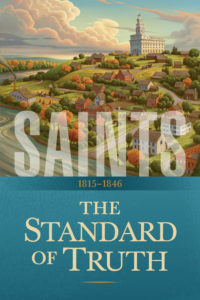 Chapter Two of saints ended right after the immediate aftermath of First Vision. Chapter Three looks at the years that followed which contain some of the many highs and lows of the life of the fledgling Prophet.
Chapter Two of saints ended right after the immediate aftermath of First Vision. Chapter Three looks at the years that followed which contain some of the many highs and lows of the life of the fledgling Prophet.
I have always loved how Joseph Smith candidly admits in his history that in the years after the First Vision, he fell into temptations and lost sight of the vision that he had. How relateable. Here is how this is described in Saints:
“Joseph and his friends were young and lighthearted. Sometimes they made foolish mistakes, and Joseph found that being forgiven once did not mean he would never need to repent again. Nor did his glorious vision answer every question or forever end his confusion. …Joseph was still unsure if God was pleased with him. He could no longer feel the forgiveness and peace he had felt after his vision of the Father and Son. Instead, he often felt condemned for his weakness and imperfections.”
I love being able to click on the footnotes in Saints and instantly be transported to the primary sources. These paragraphs combined information from the well-known account in the Pearl of Great Price, and also from an earlier 1832 account. The 1832 account has some wonderful details such as Joseph’s description of how his transgressions and sins “brought a wound upon my soul.” Joseph’s earlier account also lays bare how difficult and painful these years were for Joseph: as “his Fathers family have suffered many persecutions and afflictions.”
This backdrop gives Moroni’s visit a much deeper resonance. Joseph once again needed personal reassurance of his standing before God. He had “full confidence in obtaining a divine manifestation,” and yet imagine the relief he must have felt when a heavenly messenger appeared before him.
And yet, despite the vision Joseph did not become transformed overnight. The first time that Joseph tries to get the gold plates does not go well to say the least. He is warned that he must not seek the plates for financial gain. “Still, Joseph could not help thinking that he now knew exactly where to find enough treasure to free his family from poverty.” (Saints).
After Joseph is rebuked for seeking the plates, Moroni appears and Joseph Smith has another remarkable vision that I had not been aware of:
“Look,” Moroni commanded. Another vision unfolded before Joseph, and he saw Satan surrounded by his numberless host. “All this is shown, the good and the evil, the holy and impure, the glory of God and the power of darkness,” the angel declared, “that you may know hereafter the two powers and never be influenced or overcome by that wicked one.”
Joseph was undoubtedly aware of Satan after the assault proceeding the First Vision, and yet here Joseph is given to fully understand the power and influence of the adversary and how forcefully Satan would oppose him. I suspect that this must have been quite a wake up call for him.
Saints does not skimp in its depiction of one of the traumatic events of Joseph’s life–the death of his Brother Alvin. Immediately after the visit of Moroni, Joseph’s home was filled with joy. “Night after night he captivated the family with talk of the gold plates and the people who wrote them.” And then suddenly, his brother Alvin dies. The event was devastating to all the members of the household, especially Joseph Sr. who is described as “furious.” Neither Joseph Sr. nor Joseph Jr. ever forgot Alvin and many later events were influenced by his passing.
The second attempt to get the plates went slightly better than the first. Joseph got the plates out of the ground. And then he realized that the other items with the plates could be valuable and so he set the plates down out of his sight. Because he was not cautious with the plates, he is denied access to them again. Joseph had grown from the first encounter with Moroni, and yet he also still had a long way to go.
What stood out to you in this chapter? What did you learn? What questions did you have?

He Called Me By Name by Liz Lemon Swindle
